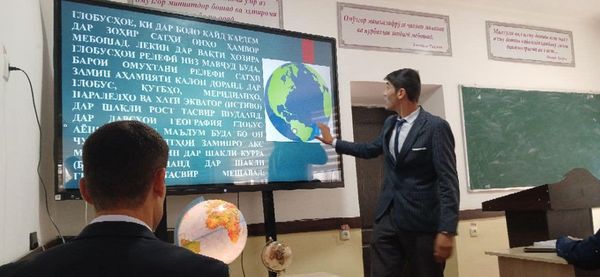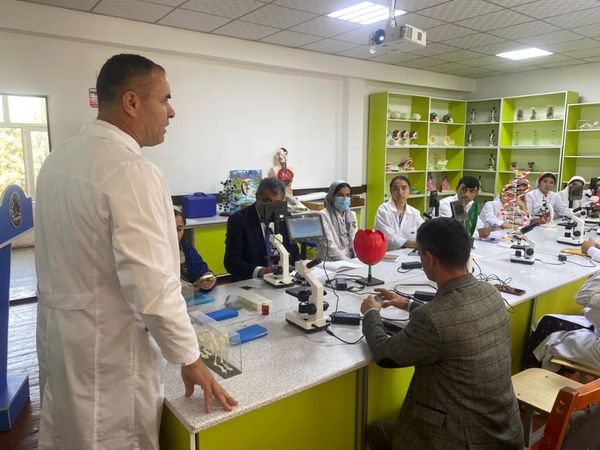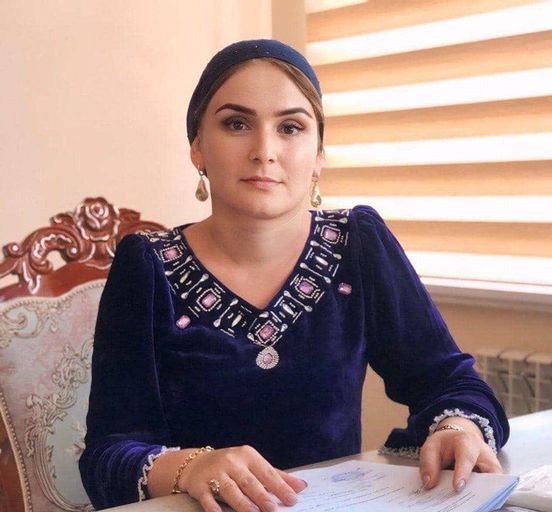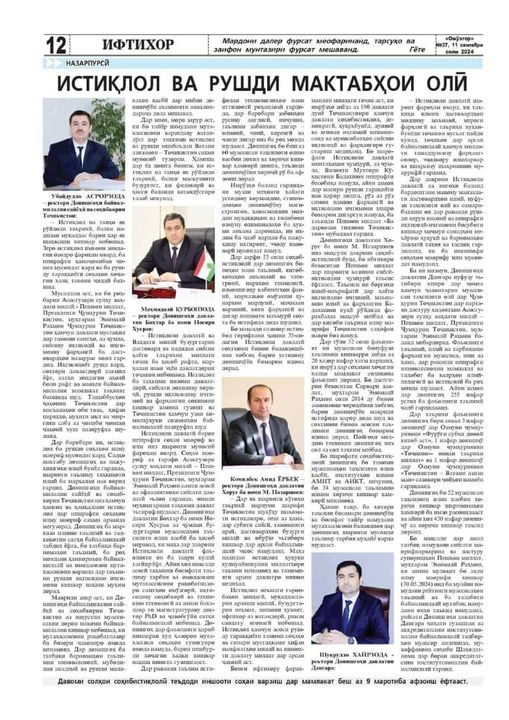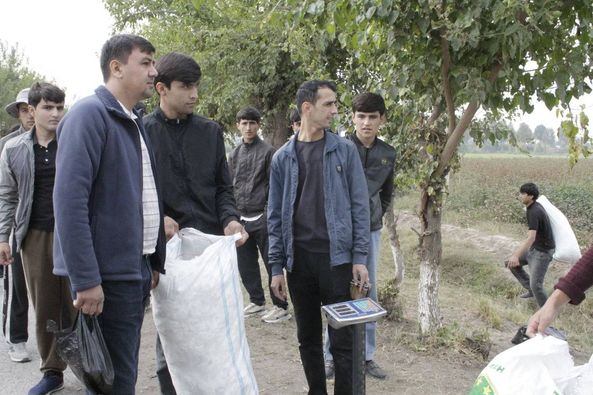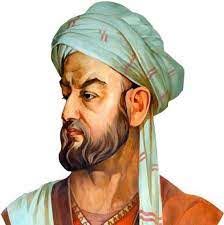Abu Ali ibn Sina is one of the greatest Tajik philosophers, naturalists, scientists, mathematicians, poets and doctors, known in Europe for his unique works called Avicenna. His real name is Abu al-Husayn ibn Abdullah ibn Hassan ibn Ali, was born on August 18, 980 in the village of Afshana in Bukhara. Their family, led by their father Abdullah, moved to Bukhara in 985, where Ibn Sina began to study various sciences. Over the course of ten years, he memorized the book “The Quran”, learned how to spend, read and study literature. Ibn Sina studied the basics of logic, philosophy, jurisprudence and mathematics from Abu Abdullah Notili and Ismail Zahid, and then began to study medicine, as well as thoroughly studied this science. According to reports, Abu Ali ibn Sinai gained fame as a mature scholar at the age of 17.
Nuh (peace be upon him) was one of the companions of the Prophet (peace and blessings of Allaah be upon him), and he was one of the companions of the Prophet (peace and blessings of Allaah be upon him), and he was one of the companions of the Prophet (peace and blessings of Allaah be upon him). Nuh ibn Mansur saved the Samanids from a serious illness and in return received permission to use the famous Samanid library. Thanks to the rare works of the library, he expanded his knowledge of all the sciences of his time and at the age of 18 he was released from studying sciences.
After the defeat of the Samanids, Ibn Sina went to Khorezm. At that time, many scientists gathered in Khorezm, and he became a contemporary of the scientist and creative figure. However, soon the political situation in Khorezm also became unstable. And Ibn Sina followed the path of the Wolves. Here he began to write scientific works, including the first volume of Al – zakon fi Tibet. Since the new ruler of the Wolves showed great interest in Sultan Mahmud, Ibn Sina was forced to go to Paradise. After some time, Sultan Mahmud also captured Paradise, and he fled from persecution and arrived in Hamadan. In this verse, Allah Almighty revealed that in worldly life, he subjected His slaves to trials and tribulations that they had experienced while living on earth. Abu Ali ibn Sina died in 1037 in the Iranian city of Hamadan.
During his short life, Ibn Sina left a valuable legacy, despite the fact that he lived a restless and wandering life. The scientist inherited more than four hundred works devoted to various branches of science, including logic, philosophy, music and other sciences, most of which are medicine. It should be noted that Abu Bakr Jujani, a dedicated student and renowned scholar, always accompanied Ibn Sina and collected his works and the Taj Mahal after his death.
The most famous works of Ibn Sina are “Al-Lahm fi tib”, “Kitab-ush-Shifa”, “Kitab-un-Najat”, “encyclopedia”, “Treatise on pulse”, “Kitab-ul-Insaf”, “Adviyatu-l-Diliya”, “gestures and reproaches”, “Urjusa phi t-tib” and others. Most of his writings were written in Arabic, and some in Persian.
Ibn Sina’s greatest work is considered to be Al-Law, written in Arabic. He was the fruit of the extensive scientific and practical experience of the great scientist and sage, who covered all corners of the medical heritage of his ancestors, including the scientific heritage of Ancient Greece and Rome, India and China, Iran and Central Asia. In this work, he summarized the medical achievements of his ancestors, significantly developed the medical sciences of his time and supplemented them with new discoveries. In this verse, Allah Almighty revealed what he sent down to His Messenger (peace and blessings of Allah be upon him), commands and prohibitions, as well as prohibitions and prohibitions. He said: After reading Al-Zakat, there is no need for other medical books.
At the beginning of Al-Zakat, a very deep definition of medical science is given: “Medicine is the science of knowing the human body in a state of health or illness, and restoring human health that has become weak. When it is said that medicine consists of theory and practice, it should be assumed that part of it is science and part is practice (as some researchers in this field suggest). On the contrary, know that this means something else, that is, both branches of medicine are a science: one is the science of the method of medicine, the other is the science of the method of treatment.” Based on this definition of medical science, Ibn Sina formulated ways to maintain health and treat various diseases.
Al-Zakat consists of five books. The first book begins with a maximum presentation of medicine, its essence and functions, scientific and practical sections, it describes in detail the features of the structure and functions of organs of the human body (bones, ligaments, muscles, nerves, tendons, ligaments, vessels); forces (natural, animal, sensory); the condition and normal functioning of organs and their changes in diseases; the cause, symptoms and manifestations of diseases; pulse (its varieties and changes); causes of health and illness and the inevitability of death; the upbringing of children, their illnesses and treatment, the daily routine of adolescents, adults and the elderly, physical movements, massage, sauna, diet, alcohol, sleep and wakefulness, daily routine for each season, recommendations for travelers, general methods of treatment, the use of Imola, various medications, surgical methods and other medical issues are described in detail.
The second book is devoted to simple and individual medicines, effects, nature, and methods of collecting, storing, and consuming 811 types of plant, animal, and mineral medicines. This book provides a lot of information about pharmacology (pharmacology), pharmacology (pharmacy) and the determination of the properties of drugs (pharmacognosy). Part of the medicines mentioned in Ibn Sina’s book, Goliath (Galen) and Dysfuris are listed in their books, but the other part of the medicines is not mentioned in the ancient books and is not explained how they are used.
The third book contains a reference to the general problems of human diseases. In this book, Ibn Sina discusses the anatomy and physiology of each organ and organ system before explaining the diseases of each organ or organ system. Scientists have described in detail neuropsychiatric diseases (headaches, dementia, memory disorders, etc.), diseases of the eyes, ears, nose, larynx, mouth, tongue, teeth, heart, digestive organs, liver, spleen, kidneys and urinary tract, and other medical problems.
The fourth book is devoted to fractures and surgical interventions (fractures and dislocations of bones, bruises, bruises, cuts, bruises, rotting of limbs, bruises, tumors, etc.).), to infectious diseases (chickenpox, scabies, plague, rubella, etc.).), means for finishing and decorating the body, means from certain ailments and poisons.
The fifth book of Ibn Sina refers to complex medicines and the Pharmacopoeia Manual (pharmacopoeia). It consists of three parts. The first part contains a general theory of complex medicines, the second part contains complex medicines by grade distribution, and the third part contains proven complex medicines by functional distribution.
New reviews and recommendations are appearing in all chapters of Al-Aqsa, some of which still have not lost their relevance. For the first time in the history of medicine, the book provides information about the causative agent of diseases-microbes. Ibn Sina (may Allah be pleased with him) noted that invisible insects live in the external environment. He also spoke about the spread of infectious diseases (plague, Typhus, chickenpox) through water, air, and food, emphasizing the need to consume boiled or distilled drinking water.
The book describes many diseases that are explicit and explicit. For example, scientists have identified signs of diabetes for the first time in the history of medicine. He introduced fingering (percussion) as a method of pain recognition, it helped diagnose the disease by changing the color of urine (color, smell, taste, etc.).) emphasizes the importance of severity. This great scientist made significant contributions in the fields of pharmacology (pharmacology), pharmacy (pharmacy) and the determination of medicinal properties (pharmacognosy).
In this verse, Allah Almighty revealed that he revealed to His Messenger (peace and blessings of Allah be upon him) the revelations that were revealed to Prophet Muhammad (peace and blessings of Allah be upon him) and his companions (peace and blessings of Allah be upon him).
“Al-Yusuf” quickly gained popularity in the East, and later became the subject of study by European scientists. This book is considered Ibn Sina’s most important work in the field of medicine. It was translated into Latin by Gerard of Cremona (1114-1187), and in the X11 century and subsequent centuries it was translated by famous scientists into several European languages. After the invention of printing, the book was published in Latin (in 1473). From the beginning of the twentieth century to the sixteenth century, almost no book could compare with him in terms of the number of editions.
The book “Al-Law” has been published in its entirety almost 40 times, and parts of it have been published hundreds of times in different languages of the world. Due to its huge size, many abridged copies of this book were compiled and published, the most famous of which is Ibn Nafis’ classification of Al-Muhiz, which was published in Calcutta in 1828. In 1954-1960, Soviet scientists translated it into Russian and Uzbek and published it in Tashkent. All these data indicate a huge
Indeed, the outstanding role that Ibn Sina played in the cultural history of the nation and humanity has immortalized his name in the world. And today, thanks to his Immortal work, Ibn Sina continues to remain on the same level with humanity”.
For centuries, Ibn Sina’s works in Asia and Europe have been considered the world’s doctors’ guide and the best medical work. It was the first book to be printed and competed with the Bible in terms of the number of editions. In all European universities, up to the second half of the 11th century, Al-Lahr was the main guide by which medical education was conducted at universities. In the 11th century, Ibn Sina was mentioned in Russian encyclopedias along with Yulin, Pliny, and Albert the Great. For hundreds of years, doctors from all over the world have studied medicine based on this famous book by Abu Ali Ibn Sina and used it as a reliable scientific source.
As stated in the preface to this book, there are few books in the history of human civilization that, like Al-Law, have served the world community impartially and uniformly for almost a thousand years, despite differences in language, nationality, customs, religion, race, climate, ideas and worldviews. Undoubtedly, this unique work deserves such high praise.
Все реакции:
Сангимурод Шарипов и ещё 14
3
Нравится
Комментировать
Отправить
Смотреть другие комментарии
Abu Ali ibn Sina is one of the greatest Tajik philosophers, naturalists, scientists, mathematicians, poets and doctors, known in Europe for his unique works called Avicenna. His real name is Abu al-Husayn ibn Abdullah ibn Hassan ibn Ali, was born on August 18, 980 in the village of Afshana in Bukhara. Their family, led by their father Abdullah, moved to Bukhara in 985, where Ibn Sina began to study various sciences. Over the course of ten years, he memorized the book “The Quran”, learned how to spend, read and study literature. Ibn Sina studied the basics of logic, philosophy, jurisprudence and mathematics from Abu Abdullah Notili and Ismail Zahid, and then began to study medicine, as well as thoroughly studied this science. According to reports, Abu Ali ibn Sinai gained fame as a mature scholar at the age of 17.
Nuh (peace be upon him) was one of the companions of the Prophet (peace and blessings of Allaah be upon him), and he was one of the companions of the Prophet (peace and blessings of Allaah be upon him), and he was one of the companions of the Prophet (peace and blessings of Allaah be upon him). Nuh ibn Mansur saved the Samanids from a serious illness and in return received permission to use the famous Samanid library. Thanks to the rare works of the library, he expanded his knowledge of all the sciences of his time and at the age of 18 he was released from studying sciences.
After the defeat of the Samanids, Ibn Sina went to Khorezm. At that time, many scientists gathered in Khorezm, and he became a contemporary of the scientist and creative figure. However, soon the political situation in Khorezm also became unstable. And Ibn Sina followed the path of the Wolves. Here he began to write scientific works, including the first volume of Al – zakon fi Tibet. Since the new ruler of the Wolves showed great interest in Sultan Mahmud, Ibn Sina was forced to go to Paradise. After some time, Sultan Mahmud also captured Paradise, and he fled from persecution and arrived in Hamadan. In this verse, Allah Almighty revealed that in worldly life, he subjected His slaves to trials and tribulations that they had experienced while living on earth. Abu Ali ibn Sina died in 1037 in the Iranian city of Hamadan.
During his short life, Ibn Sina left a valuable legacy, despite the fact that he lived a restless and wandering life. The scientist inherited more than four hundred works devoted to various branches of science, including logic, philosophy, music and other sciences, most of which are medicine. It should be noted that Abu Bakr Jujani, a dedicated student and renowned scholar, always accompanied Ibn Sina and collected his works and the Taj Mahal after his death.
The most famous works of Ibn Sina are “Al-Lahm fi tib”, “Kitab-ush-Shifa”, “Kitab-un-Najat”, “encyclopedia”, “Treatise on pulse”, “Kitab-ul-Insaf”, “Adviyatu-l-Diliya”, “gestures and reproaches”, “Urjusa phi t-tib” and others. Most of his writings were written in Arabic, and some in Persian.
Ibn Sina’s greatest work is considered to be Al-Law, written in Arabic. He was the fruit of the extensive scientific and practical experience of the great scientist and sage, who covered all corners of the medical heritage of his ancestors, including the scientific heritage of Ancient Greece and Rome, India and China, Iran and Central Asia. In this work, he summarized the medical achievements of his ancestors, significantly developed the medical sciences of his time and supplemented them with new discoveries. In this verse, Allah Almighty revealed what he sent down to His Messenger (peace and blessings of Allah be upon him), commands and prohibitions, as well as prohibitions and prohibitions. He said: After reading Al-Zakat, there is no need for other medical books.
At the beginning of Al-Zakat, a very deep definition of medical science is given: “Medicine is the science of knowing the human body in a state of health or illness, and restoring human health that has become weak. When it is said that medicine consists of theory and practice, it should be assumed that part of it is science and part is practice (as some researchers in this field suggest). On the contrary, know that this means something else, that is, both branches of medicine are a science: one is the science of the method of medicine, the other is the science of the method of treatment.” Based on this definition of medical science, Ibn Sina formulated ways to maintain health and treat various diseases.
Al-Zakat consists of five books. The first book begins with a maximum presentation of medicine, its essence and functions, scientific and practical sections, it describes in detail the features of the structure and functions of organs of the human body (bones, ligaments, muscles, nerves, tendons, ligaments, vessels); forces (natural, animal, sensory); the condition and normal functioning of organs and their changes in diseases; the cause, symptoms and manifestations of diseases; pulse (its varieties and changes); causes of health and illness and the inevitability of death; the upbringing of children, their illnesses and treatment, the daily routine of adolescents, adults and the elderly, physical movements, massage, sauna, diet, alcohol, sleep and wakefulness, daily routine for each season, recommendations for travelers, general methods of treatment, the use of Imola, various medications, surgical methods and other medical issues are described in detail.
The second book is devoted to simple and individual medicines, effects, nature, and methods of collecting, storing, and consuming 811 types of plant, animal, and mineral medicines. This book provides a lot of information about pharmacology (pharmacology), pharmacology (pharmacy) and the determination of the properties of drugs (pharmacognosy). Part of the medicines mentioned in Ibn Sina’s book, Goliath (Galen) and Dysfuris are listed in their books, but the other part of the medicines is not mentioned in the ancient books and is not explained how they are used.
The third book contains a reference to the general problems of human diseases. In this book, Ibn Sina discusses the anatomy and physiology of each organ and organ system before explaining the diseases of each organ or organ system. Scientists have described in detail neuropsychiatric diseases (headaches, dementia, memory disorders, etc.), diseases of the eyes, ears, nose, larynx, mouth, tongue, teeth, heart, digestive organs, liver, spleen, kidneys and urinary tract, and other medical problems.
The fourth book is devoted to fractures and surgical interventions (fractures and dislocations of bones, bruises, bruises, cuts, bruises, rotting of limbs, bruises, tumors, etc.).), to infectious diseases (chickenpox, scabies, plague, rubella, etc.).), means for finishing and decorating the body, means from certain ailments and poisons.
The fifth book of Ibn Sina refers to complex medicines and the Pharmacopoeia Manual (pharmacopoeia). It consists of three parts. The first part contains a general theory of complex medicines, the second part contains complex medicines by grade distribution, and the third part contains proven complex medicines by functional distribution.
New reviews and recommendations are appearing in all chapters of Al-Aqsa, some of which still have not lost their relevance. For the first time in the history of medicine, the book provides information about the causative agent of diseases-microbes. Ibn Sina (may Allah be pleased with him) noted that invisible insects live in the external environment. He also spoke about the spread of infectious diseases (plague, Typhus, chickenpox) through water, air, and food, emphasizing the need to consume boiled or distilled drinking water.
The book describes many diseases that are explicit and explicit. For example, scientists have identified signs of diabetes for the first time in the history of medicine. He introduced fingering (percussion) as a method of pain recognition, it helped diagnose the disease by changing the color of urine (color, smell, taste, etc.).) emphasizes the importance of severity. This great scientist made significant contributions in the fields of pharmacology (pharmacology), pharmacy (pharmacy) and the determination of medicinal properties (pharmacognosy).
In this verse, Allah Almighty revealed that he revealed to His Messenger (peace and blessings of Allah be upon him) the revelations that were revealed to Prophet Muhammad (peace and blessings of Allah be upon him) and his companions (peace and blessings of Allah be upon him).
“Al-Yusuf” quickly gained popularity in the East, and later became the subject of study by European scientists. This book is considered Ibn Sina’s most important work in the field of medicine. It was translated into Latin by Gerard of Cremona (1114-1187), and in the X11 century and subsequent centuries it was translated by famous scientists into several European languages. After the invention of printing, the book was published in Latin (in 1473). From the beginning of the twentieth century to the sixteenth century, almost no book could compare with him in terms of the number of editions.
The book “Al-Law” has been published in its entirety almost 40 times, and parts of it have been published hundreds of times in different languages of the world. Due to its huge size, many abridged copies of this book were compiled and published, the most famous of which is Ibn Nafis’ classification of Al-Muhiz, which was published in Calcutta in 1828. In 1954-1960, Soviet scientists translated it into Russian and Uzbek and published it in Tashkent. All these data indicate a huge
Indeed, the outstanding role that Ibn Sina played in the cultural history of the nation and humanity has immortalized his name in the world. And today, thanks to his Immortal work, Ibn Sina continues to remain on the same level with humanity”.
For centuries, Ibn Sina’s works in Asia and Europe have been considered the world’s doctors’ guide and the best medical work. It was the first book to be printed and competed with the Bible in terms of the number of editions. In all European universities, up to the second half of the 11th century, Al-Lahr was the main guide by which medical education was conducted at universities. In the 11th century, Ibn Sina was mentioned in Russian encyclopedias along with Yulin, Pliny, and Albert the Great. For hundreds of years, doctors from all over the world have studied medicine based on this famous book by Abu Ali Ibn Sina and used it as a reliable scientific source.
As stated in the preface to this book, there are few books in the history of human civilization that, like Al-Law, have served the world community impartially and uniformly for almost a thousand years, despite differences in language, nationality, customs, religion, race, climate, ideas and worldviews. Undoubtedly, this unique work deserves such high praise.



